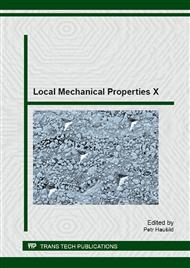p.121
p.125
p.129
p.133
p.137
p.141
p.145
p.151
p.155
Modeling of Stress Distribution in Dental Implant in Frontal Part of Mandible
Abstract:
The aim of this work is the modeling of the stress distribution in cortical and trabecular bone of model frontal part of mandible by FEM analysis using linear static methods applying monocortical and bicortical fixation of dental implant. Depending on the position of the screw thread with regard to the bone surface, three different cases were simulated: exactly on the bone surface, 1,5 mm above and 0,5 mm below the surface of the cortical bone. It was found out that the stress field in the cortical part and the implant are considerably lower in the case of slightly recessed position in contrast with the above and normal position of the implant in both, monocortical and bicortical fixations. However, bicortical fixation in this case generates slightly lower stress field in the bone and implant parts than in monocortical fixation. Monocortical fixation is otherwise slightly more favorable from the viewpoint of maximum stresses in the bone in the case of exact and above positions of the implant.
Info:
Periodical:
Pages:
137-140
Citation:
Online since:
March 2014
Authors:
Keywords:
Price:
Сopyright:
© 2014 Trans Tech Publications Ltd. All Rights Reserved
Share:
Citation:


